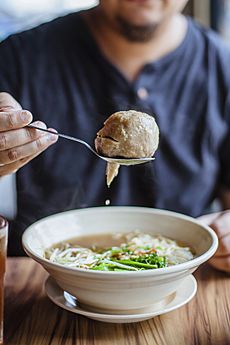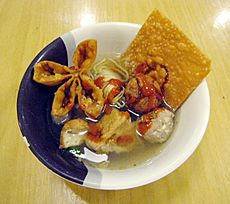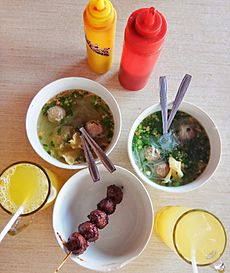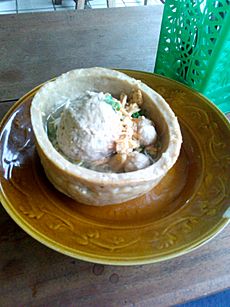Bakso facts for kids

Bakso served with bihun (rice vermicelli) and fried wontons
|
|
| Course | Main |
|---|---|
| Place of origin | Indonesia, derived from the Chinese meatball |
| Region or state | Nationwide |
| Serving temperature | Hot |
| Main ingredients | Ground beef, tapioca, noodle, rice vermicelli, beef broth, kailan, celery, salted vegetables, fried shallots |
| Variations | Bakwan Malang, phở bò viên (Vietnamese noodle soup with meatballs), Chinese beef balls |
| 1 medium ball of bakso contains 21 mg cholesterol, 134 mg sodium, and 57 calories. kcal | |
Bakso (also called baso) is a popular Indonesian meatball. It's made from finely ground meat, usually beef. Bakso has a bouncy texture, much like Chinese meatballs made from beef, fish, or pork. The word bakso can mean just one meatball or the whole soup dish it comes in.
If you hear Mie bakso, it means bakso served with yellow noodles and rice vermicelli. Bakso kuah is just the bakso soup without noodles.
You can find bakso all over Indonesia, from street vendors to fancy restaurants. It's one of Indonesia's most loved street foods, just like soto, satay, and siomay. Today, you can even buy ready-to-cook bakso as frozen food in Indonesian supermarkets. People usually eat it with noodles.
Contents
What is Bakso Made Of?
Bakso is usually made from finely ground beef mixed with a little tapioca flour and salt. But it can also be made from chicken, pork, fish, or shrimp. Unlike other meatballs, bakso has a very firm, smooth, and bouncy texture. This is because of how the meat is prepared.
Most people in Indonesia are Muslims. They follow halal food rules. So, bakso is usually made from beef, chicken, or a mix of both. In places with many non-Muslims, like some Chinatowns or the island of Bali, you might find pork bakso.
Traditionally, the meat paste is shaped into balls by hand. Then, these balls are boiled in hot water. Once cooked, the meatballs are dried and served. Or, they can be kept in the fridge for later. Street vendors often show their pre-cooked bakso in their carts.
How is Bakso Served?
Bakso is usually served in a bowl of beef broth. It comes with yellow noodles, bihun (rice vermicelli), salted vegetables, tofu, and sometimes an egg inside the bakso. You might also find Chinese broccoli, bean sprouts, siomay (steamed meat dumplings), and crispy wontons. It's often topped with fried shallots and celery.
Sometimes, slices of bakso are added to other dishes like mie goreng (fried noodles), nasi goreng (fried rice), or cap cai (stir-fried vegetables).
Where Did Bakso Come From?
The name bakso comes from the Chinese Hokkien words bak-so. This means "fluffy meat" or "minced meat." This suggests that bakso has Chinese Indonesian roots. Many Indonesian foods show Chinese influences, like bakmi, mie ayam, pangsit, mie goreng, kwetiau goreng, and lumpia.
Bakso's texture is very similar to Chinese beef balls, which are also fluffy and smooth. Even though bakso has a Chinese name, experts think it might be a mix of different cooking styles from when the Dutch ruled Indonesia. In Indonesia, "meatball" (bola daging) often means Western-style meatballs, which are different from bakso. For example, Swedish meatballs are called bola daging Swedia.
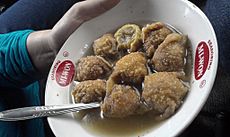
Even with its possible Chinese origin, bakso has become very Indonesian, especially in Chinese Indonesian and Javanese cuisine. Today, many bakso sellers are Javanese from Wonogiri and Malang.
Bakso Solo and Bakso Malang are the most famous types. Bakso Solo comes from Solo in Central Java. It is usually served with yellow noodles and rice vermicelli in beef broth. Bakso Malang comes from Malang in East Java. It often includes tofu and crispy fried wontons. In Malang, bakso bakar (roasted bakso) is also very popular.
In Bandung, West Java, there is a type of bakso called bakso cuanki. It's similar to bakso Malang. It can have different bakso ingredients, like bakso aci, siomay dumplings, boiled wontons, fried wontons, and fried bakso, all served in a broth.
Different Kinds of Bakso
Indonesia has many different types of bakso. They can be different in shape, size, texture, ingredients, and what's inside them.
- Bakso aci: A meatball with more tapioca flour, making it chewier.
- Bakso ayam: Bakso made from chicken.
- Bakso babi: Bakso made from pork.
- Bakso bakar: Grilled bakso on a skewer, like satay.
- Bakso beranak: A large bakso filled with smaller meatballs inside.
- Bakso bola tenis: Bakso the size of a tennis ball. It can be filled with a hard-boiled egg (bakso telur) or pieces of beef fat and tendons (urat).
- Bakso cuanki: A famous bakso from Bandung, West Java.
- Bakso gepeng: Flat beef bakso, usually very smooth.
- Bakso goreng: Fried bakso with a firm texture. It's often eaten as a snack or added to bakso Malang.
- Bakso ikan: Bakso made from fish (fish ball).
- Bakso keju: A modern bakso filled with cheddar or mozzarella cheese.
- Bakso kotak: Cube-shaped bakso.
- Bakso Malang: A bakso dish from Malang, East Java. It comes with noodles, tofu, siomay, and fried wontons.
- Bakso mercon: Means "firecracker bakso." It's super spicy, filled with sambal (chili paste).
- Bakso tahu: Bakso meat dough stuffed into tofu.
- Bakso telur: A tennis ball-sized bakso with a hard-boiled chicken egg inside.
- Bakso udang: Bakso made from shrimp, usually light pink.
- Bakso urat: Bakso filled with tendons and coarse meat.
What to Add to Your Bakso
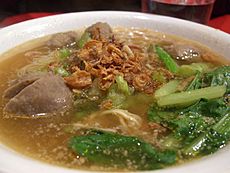
Bakso stalls usually have bottles of sauces and other things you can add. You can put these in your bowl to make your bakso taste just how you like it. Here are some common additions:
- Bawang goreng: Crispy fried shallots sprinkled on top.
- Kecap manis: Sweet soy sauce to add a mild sweetness.
- Sambal: Chili paste to make it spicy.
- Bottled hot sauce.
- Ketchup: Tomato sauce.
- Vinegar: To add a sour taste.
- Tongcay: Preserved salted vegetables.
Why is Bakso So Popular?
Bakso is one of the most popular street foods in both Indonesian cities and villages. Traveling vendors on carts or bikes often visit neighborhoods. You can also find simple bakso stalls on street sides in cities.
Bakso became famous worldwide when former United States President Barack Obama said it was one of his favorite foods from his childhood in Indonesia. It was also a challenge on TV shows like The Amazing Race Asia 1, The Amazing Race Australia 1, and The Amazing Race 28. Teams had to either sell or eat bakso.
Sometimes, traveling meatball vendors are joked about as being secret agents. There are many memes online showing bakso vendors talking on walkie-talkies. This is just a funny way to imagine them.
Similar Dishes Around the World
Similar meatball dishes can be found in other Southeast Asian cuisines, like in Thailand, Vietnam, Malaysia, and Singapore. There are also Chinese-style meatballs.
One similar dish is the Vietnamese noodle soup with meatballs, phở bò viên. In Vietnam, Phở means noodle soup, and Bò Viên means meatballs. Phở Bò Viên is a type of Phở and is considered a national dish of Vietnam.
In Malaysia and Singapore, there's a similar meatball soup called bebola daging. This is just the Malay translation for "meatball." Many bebola daging recipes in Malaysia and Singapore come from Western (like Indian or European) or Eastern (Chinese) meatballs.
In the Philippines, meatballs are called almondigas or bola-bola. They are usually served in a misua noodle soup with toasted garlic, squash, and pork cracklings. Bola-bolas can also be stewed or pan-fried until golden brown.


